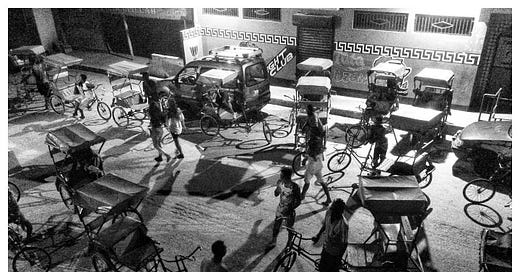The light is low, the movement is fluid: even the shadows in this scene seem poised for encounters. The people move in both directions at once, their repeated goings and comings as sure as the rotary motion of the wheels, as though there is no designated destination. And yet, for a scene depicting movement, there seems to be little hurry in the mood. The ease in the frame marks a distinction between cycling and driving, perhaps between patience and haste.
— Emmanuel Iduma
“This southern city gives off an indescribable energy that awakens the soul.”
This picture was taken in Tulear, Madagascar in March 2021, with an iPhone 5s smartphone from the upstairs window of a nightclub. The scene was there, I just had to immortalize it by taking care of the framing.
I chose this photo because it shows the atmosphere of the night life in Tulear, the order in the disorder, the individual in the group. We feel the effervescence, a kind of “happy brothel.” Described as a city that never sleeps (“Toliara tsy miroro”) hence the title of the photo “Tsy Miroro,” this southern city gives off an indescribable energy that awakens the soul.
My approach to photography depends on the situation I am in. For me the basis is communication. Yes, photography can make a change in the world we live in.
— Henitsoa Rafalia
About Henitsoa Rafalia
Born in Madagascar, Henitsoa Rafalia works in Antananarivo. In 2014, he became a correspondent for the Turkish news agency Anadolu Agency and joined the European Pressphoto Agency as a photojournalist in 2018. He collaborates with other international press organs and is also consulting photographer for NGOs and international organizations. His work has been exhibited widely in Madagascar. With three other Malagasy photojournalists, he co-founded the Mira Photo Collective. The same year, with another Malagasy photographer, he launched an itinerant photographic project entitled “Galerie à ciel ouvert” with the aim of bringing photography back to the streets by freely exhibiting photos on the walls of Madagascar's cities. More of his work can be found on his Instagram page, and he can be reached via Facebook and Linkedin.
Last Week — “Guguletu Grads” by Julius Adorsu
My approach is to be an excellent observer of all things before even thinking about bringing my camera out. I read situations; some things are too sensitive and better to not be captured. I try to use my moral/human compass to guide me. It never steers me wrong.
This is the 68th edition of this publication, which also read on web (best for viewing images), and via the Substack iOS/Android apps.
Every Wednesday I feature one photograph and the photographer who took it: you’d read a short caption from me, and a statement from the photographer. And every Saturday I publish a lengthier engagement with the work featured in the newsletter. My goal is to engage with early to mid-career African photographers, and to create a platform in which photographers lead the cataloguing and criticism of their work.
Thank you for reading. If this newsletter was shared with you, consider subscribing, or forward to a friend. Please whitelist the newsletter to ensure you never miss it.






Missed this the first time around -- one of my new favorites.